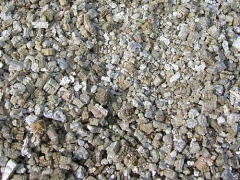Vermiculite
| Infobox on Vermiculite | |
|---|---|
| Example of Vermiculite |  |
| Facts | |
| Origin | Large commercial vermiculite mines currently exist in Russia, South Africa, USA, China and Brazil |
| Stowage factor (in m3/t) | - |
| Humidity / moisture | 0,5% |
| Ventilation | - |
| Risk factors | See text |
Vermiculite
Description
Vermiculite is the name used in commerce for a group of micaceous minerals that expand or exfoliate many times (commercial varieties esfoliate 8 to 20 times or more) the original thickness when heated. They show the characteristic micaceous structure of basal cleavage and occur as soft, pliable inelastic laminae. Their basal cleavages are not so perfect as those of mica. Vermiculite exists in a wide range of colours from black through various shades of brown to yellow. Its chemical composition varies widely consisting of a complex hydrated aluminium, magnesium silicate. Hence, the analysis of the mineral is of little use in determining the vermiculite for commercial utility; a technical trial of the material provides the only satisfactory test. Vermiculite owes its commercial utility to its property of exfoliation when heated. It exfoliates into a yellow to bronze coloured mass giving an appearance of a cluster of worms - vermiculus, an Italian word for worm from which it has derived its name.
Application
Use; lightweight concrete aggregate, insulation, sound conditioning, fireproofing, plaster, soil conditioner, additive for fertilizers, seed bed for plants, refractory, lubricant, oil well drilling mud. Filler in rubber, paint, plastics. Wall paper printing, removal of strontium-90 from milk, absorption of oil spills on seawater, animal feed additive, packing, carrier for insecticides, catalyst and catalyst support, litter for hatcheries, adsorbent.
Vermiculite is always used in exfoliated form. When exfoliated, it possesses nearly 10 to 11 times less bulk density than the original volume. In commerce vermiculite which expands more than 10 times the original volume is regarded of good quality. With an expansion below 10 times the original volume, vermiculite is considered low grade. The low bulk density, comparatively high refractoriness, low thermal conductivity and chemical inertness make vermiculite satisfactory for many types of thermal and acoustic insulations. One of its large commercial uses is as an aggregate in light weight concrete and hard wall-plaster because of its acoustic and thermal insulating and fire-resisting qualities. The density of raw vermiculite is 50 to 90 lbs. per cu. ft. while that of the exfoliated one is 5-10 lbs. per cu. ft. It is therefore extensively used in concrete work to save weight. Vermiculite concrete weighs 20-25 per cu. ft. as concrete weighs about 100 lbs. per cu. ft. Vermiculite concrete has the same advantages as concrete made with pumice and perlite. Refractory insulations both in the form of loose vermiculite fill and vermiculite bricks are used in furnaces and kilns up to 1.100ºC. About 60% of the present world consumptions is in the form of loose fill when the expanded material is merely pured like dry sand into wall spaces or applied over ceiling constructions or attics of residential buildings with a view to insulating homes against the cold in winter and heat in the summer. Vermiculite concrete in the form of monolithic cast is used in sound-absorbing panels in aeroplane engine testing sheds.
Vermiculite, being a granular expanded aggregate with numerous air voids, when mixed with a suitable binder, develops sound insulating properties. Vermiculite plaster is widely used for better acoustics and reduction of noise in auditoriums, wireless studios, theatres, hospitals, etc. Vermiculite mixed with three parts of gypsum is used as plaster for sound-absorbing purposes.
More than hundred major and minor uses of vermiculite have been developed in the fields of agriculture, pesticides, lubricants, disinfectants, plastics and light-weight insulating bricks.
Shipment / Storage / Risk factors
Vermiculite is used in insulation, fire proofing and refractories. When wetted, vermiculite flakes swell slightly, become soft and slippery and break down into scales. The wet ore sticks together and will not readily flow. Handling and transfer to silos, etc., is difficult in that case. Most end users rely on the dry flow characteristic to meter the feed to furnaces. Commercial furnaces are designed to process only dry ore. Even if damp ore did reach the furnace the resulting product would be incompletely processed and not saleable.
Vermiculite ore contaminated by sea water should, as a general rule, be condemned as unusable. Chloride contamination would prohibit its use in concrete or any other use where it would come into contact with mild steel. Drying wet vermiculite ore could involve additional handling and energy costs, and this is not usually commercially viable.
When in the exfoliated form vermiculiteis a lightweight aggregate usually packed in paper or plastic bags weighing 6 - 16 kg.
Can absorb and hold water up to 2,5 times its own weight. It does not undergo any significant volume change as a result of absorbing water.











